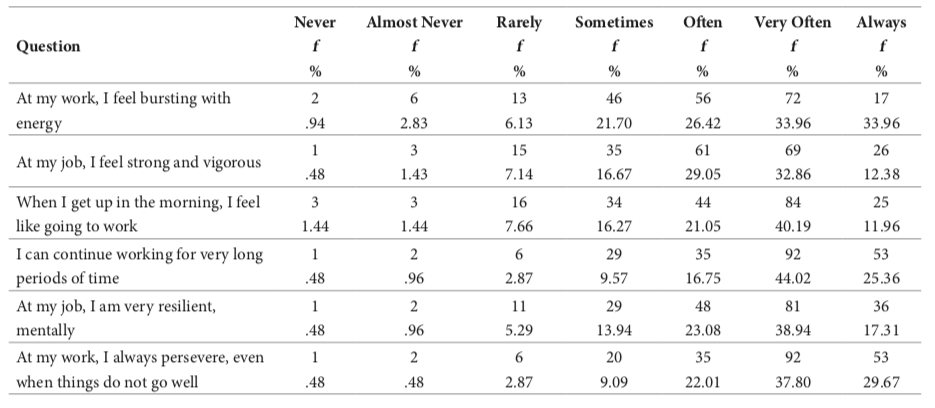CONCLUSIONS, IMPLICATIONS, AND RECOMMENDATIONS
Florida Extension agents reported possessing high levels of self-perceived overall work engagement. A composite of the average Florida Extension agent often experiences vigor, very often experiences dedication, and often experiences absorption. These findings were consistent with previous research (Abbott, 2017; Weyrauch, 2010) which likewise found that Extension agents often or very often report dedication. Florida Extension agents in this study demonstrated more dedication and absorption than Extension agents in other states (Abbott, 2017).
Table 1. Levels of Work Engagement 
Table 2. Respondents’ Perceptions of Vigor 
Table 3. Dedication Individual Responses 
Table 4. Absorption Individual Responses 
This study found that many Florida Extension agents reported experiencing absorption often or very often. Florida Extension agents were least affirmative to the statement, “It is difficult to detach myself from my job.” This statement is indicative of the concept of workaholism and thus this is a positive observation that agents may be experiencing healthy levels of absorption, but not over-absorption to the point of burnout. Despite the many studies showing that agents are susceptible to burnout (Ensle, 2005; Harder et al., 2015; Peters et al., 2008; Russell & Liggans, 2020) the population of agents in our study appear to be avoiding unhealthy engagement associated with workaholism. Although these findings are encouraging, Florida Extension Administration should train supervisors and employees in how to identify and prevent workaholism to proactively ensure that agents maintain healthy levels of engagement.
While the typical Florida Extension employee possesses a high level of self-perceived work engagement, in any organization there are those who are less engaged. Approximately 13–19% of participants indicated they experienced vigor, dedication, or absorption sometimes or less frequently. Those who suffer from low engagement are not a lost cause, as engagement is malleable and can be increased (Bakker et al., 2008). Work engagement is contagious (Bakker et al., 2008), and thus the engagement of others in an employee’s office, cohort, or team can impact their individual engagement. Team engagement can be increased when team members are collectively involved in collaborative work duties and emotionally connected to teammates (Guchait, 2016). Recognizing this, Extension supervisors should be on the lookout for those who are less engaged and intervene as necessary.
The survey for this study closed in February 2020. Beginning in March 2020, the United States was faced with the COVID-19 pandemic, which changed the way people lived and worked. Florida Extension employees found themselves suddenly working from home and learning to program virtually while dealing with other personal stressors unrelated to work stemming from the pandemic. Early studies have found that the pandemic has had a negative impact on work engagement (Jung et al., 2021; Song et al., 2020). It is recommended that future studies of Extension agent populations are conducted to uncover how this phenomenon may have impacted employee engagement. Those studies should consider age, gender, and familial roles as they relate to the pandemic’s impact on work engagement and should expand the audience to include the work engagement of regional and state Extension professionals.
Extension leadership currently has a prime opportunity to examine and adjust how employees engage with their careers. Post-pandemic, employees may be re-examining how they interact with the workforce, making attention to engagement imperative among organizations.. The higher quality and quantity of work produced by engaged Extension employees can benefit the citizens and communities we serve as they adjust to a “new normal” after this unprecedented event.
Table of Contents
- INTRODUCTION
- THEORETICAL FRAMEWORK AND REVIEW OF LITERATURE
- PURPOSE
- METHODS
- FINDINGS
- CONCLUSIONS, IMPLICATIONS, AND RECOMMENDATIONS
- REFERENCES